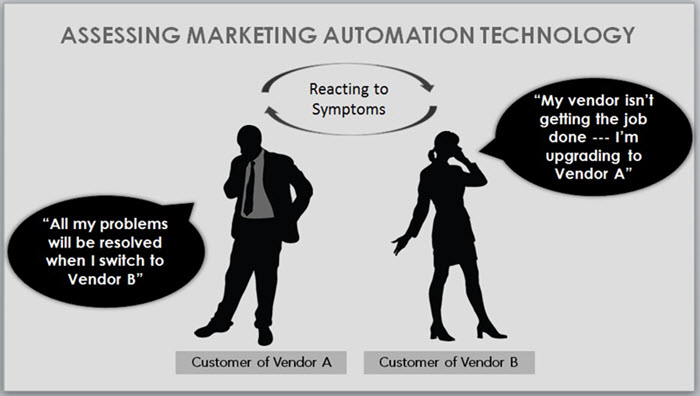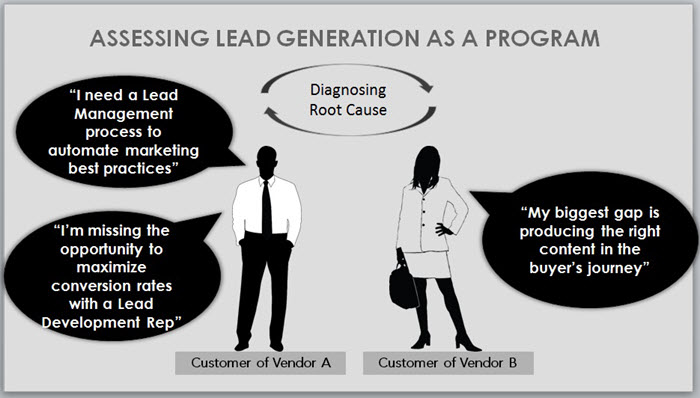The majority of marketing leaders report dissatisfaction with results from Marketing Automation. Frost & Sullivan reveals 75% not accomplishing what they expected. Failed implementations of Marketing Automation litter the battlefield. CMOs know their marketing automation isn’t delivering results but aren’t sure what to do. Do you fix or replace?
It’s not uncommon for a new client to voice their desire to dump their Marketing Automation vendor. What’s interesting is my firm has observed a trend the past two years. We call it ‘vendor envy’. A client with Brand X Marketing Automation wants Brand Y. The client with Brand Y thinks the grass is greener with Brand X.

There is something to be said about a fresh start with a new vendor. There is generally a willingness of a new vendor to go the extra mile. What is often missed is that most CMOs have invested in expensive configuration and integration. Switching vendors can be one step forward and two steps backward.
Is the Marketing Automation Vendor the problem?
There are three key questions to evaluate if your shortcoming rests in the technology vendor alone.
- My prospects are not presented with quality content based on buyer process map triggers. TRUE/FALSE
- My entire program is automated without leveraging personalized 1-to-1 nurturing. TRUE/FALSE
- My lead generation program is not guided by a documented lead management process. TRUE/FALSE
A ‘TRUE’ response to any question means the problem goes beyond technology.
Is it Best to Switch or Double-down with My Existing Vendor?
The answer is both. There is a time for each depending on your analysis. Download the ‘Marketing Automation Assessment Tool’ to understand root cause for not generating enough leads. A focus on technology alone will most likely increase cost and delay resolution. Root cause diagnosis will bring you to the right solution.
Three Most Common Root Causes of Marketing Automation Failure

1. Lack of Content
Our research shows that the #1 reason for implementation failure is lack of content. Without quality content the marketing automation system is a road to nowhere. The majority of marketing departments struggle to produce sufficient content to fuel marketing automation.
Focus on producing the right content to engage the prospect through the buyer’s journey.
2. Undefined or Lack of Lead Management Process
A Lead Management process converts early stage interest to sales qualified leads. This occurs through a documented process that is then automated. Marketing teams that operate ad-hoc suffer from below average conversion rates. World Class firms that generate optimal conversion rates share a common trait. They operate from a documented lead management process. The end result is more qualified leads flowing through the top of the funnel.
A weak process can result in a complicated configuration. In the absence of process, the Marketing Automation (M.A.) system is configured and reconfigured continually. 12-24+ months of configuration regurgitation will likely result in a spaghetti mess of configured rules. This increases complexity and decreases reliability. With the high churn rate of M.A. administrators, minor changes produce errors.
3. Over-emphasized Automation
Ultimately people buy from people. Just because you can automate something doesn’t mean you should automate everything. The Lead Management process is built on the foundation of the buyer’s process. A Buyer’s Process Map provides insights into when the right level of human interaction is required. There is a missed opportunity to exclude human intellect (role of a Lead Development Representative).
Automated nurturing plays a key role in providing timely scale. However there is a point where 1-to-1 lead nurturing provides a competitive advantage. Automated email workflows fail when they drive everything to a final point of qualification.
Buyers who are early or midway through the buying process don’t want to be ‘qualified’. They want to engage and discuss key concepts. Automation by itself causes leads to leak out. Buyers respond favorably to their first human contact that seeks to provide 1-to-1 nurturing. Forrester reports that lead nurturing increases conversion rates by more than 50%. Don’t overlook the role of a Lead Development Representative.
Which Marketing Automation System is the Best Fit?
Technology by itself is rarely the shortcoming. My firm has successful Lead generation program implementations across all the top platforms. The Marketing Automation vendors include Marketo, Eloqua, Pardot, Hubspot, Infusionsoft and Silverpop. Each vendor has advantages/disadvantages. We have experienced tremendous success with each of these vendors across multiple clients.
Analysis of fit for the ideal Marketing Automation system includes several layers of criteria;
Summary
The technology itself is rarely the root cause of poor lead generation performance. Look instead at process, people and content for the highest impact levers to pull. Download the ‘Marketing Automation Assessment Tool’ to understand root cause for not generating enough leads.




Interesting article, completely agree with the tendency to over complicate and over automate, but also feel you have missed a major part of the equation here… Data Strategy – more companies are implementing MA solutions, but have no focus on how they manage the data which underpins the whole process.
No point producing the most engaging content in the world and automated, trigger based communications program’s if you don’t have a cohesive data strategy and plan to underpin it.
t: @paul_stevenson